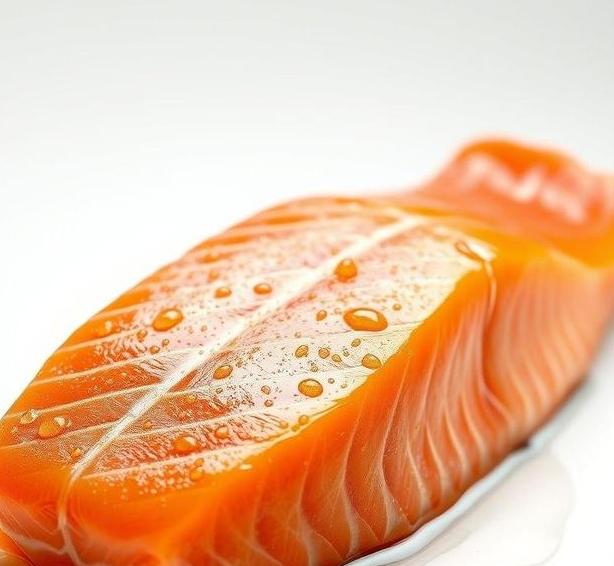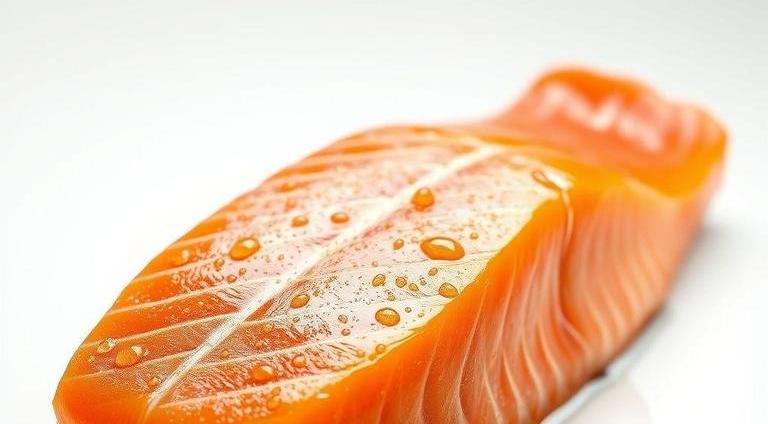Can Uncooked Salmon Go Bad : What You MUST Know
Salmon is one of the most sought-after fish in kitchens worldwide. Known for its rich, tender texture and versatile flavor, it’s a favorite in everything from sushi to grilled dishes and creamy pastas. But if you’re working with uncooked salmon, there’s an important question you need to consider: Can uncooked salmon go bad?
Yes, uncooked salmon can spoil-faster than you might think. The delicate nature of raw fish means that it has a limited window of time before it starts to degrade, and when it does, it can lead to foodborne illnesses. In this article, we’ll take a deep dive into the shelf life of uncooked salmon, how to spot the signs of spoilage, proper storage methods, and some expert tips to ensure you’re handling it correctly.
Can Uncooked Salmon Go Bad?
Absolutely, uncooked salmon is highly perishable and does go bad. Raw fish, including salmon, is susceptible to bacterial growth, oxidation, and enzyme activity, which can affect both its texture and safety. Unlike some meats that can be frozen for long periods without losing much quality, raw salmon requires careful handling, storage, and timely consumption to remain safe and fresh.
Here’s why uncooked salmon is particularly vulnerable to spoiling:
- Moisture content: Salmon is around 70-80% water. This high moisture level creates an ideal breeding ground for bacteria and pathogens.
- Enzymes: Salmon contains natural enzymes that, when exposed to air, can break down the tissue, leading to off-flavors and changes in texture.
- Temperature sensitivity: Fish should be stored at very cold temperatures, and if it’s left out too long or stored improperly, the risk of spoilage increases exponentially.
Shelf Life For Uncooked Salmon

The shelf life of uncooked salmon depends on several factors, including how fresh the fish is when you buy it, how it’s stored, and whether it’s been previously frozen. Here’s a breakdown:
-
Fresh Salmon (stored Properly In The Fridge)
Typically, fresh salmon will last 1 to 2 days in the refrigerator. It’s best to eat it as soon as possible after purchasing to enjoy it at its peak freshness.
-
Previously Frozen Salmon (thawed In The Fridge)
If the salmon was previously frozen and thawed, it will usually last 1 to 2 days in the refrigerator. Never refreeze thawed salmon.
-
Vacuum-sealed Or Packaged Salmon
If the salmon comes in vacuum-sealed packaging and has been properly refrigerated, it can last a bit longer-2 to 3 days-but always check the "use by" or "sell by" dates on the packaging to be sure.
Storage Tip
If you plan to store salmon for more than a couple of days, freezing it immediately after purchase is the best option. Salmon can last up to 6 months in the freezer if properly wrapped.
Common Signs Of Spoilage
Knowing when uncooked salmon has gone bad is crucial. While fresh salmon has a clean, slightly ocean-like smell, vibrant color, and firm texture, spoilage can happen quickly. Here are some key indicators that your salmon is no longer safe to eat:
-
Off Or Sour Odor
Fresh salmon should have a clean, ocean-like smell, but once it starts to spoil, it will develop a strong, fishy, or sour odor. If it smells overly pungent or just "off," it’s time to toss it.
-
Color Change
Fresh salmon is typically a rich pink to orange color, but when it begins to spoil, the flesh will take on a dull, grayish hue. In some cases, the edges may appear browner, and the overall appearance will look less vibrant.
-
Slimy Texture
Fresh salmon should feel moist but not overly slimy. If the surface feels slippery or sticky, this is a sign of bacterial growth. Similarly, if the flesh starts to look mushy or loses its firmness, it’s no longer safe to eat.
-
Excessive Liquid
When raw salmon releases excessive liquid or seems overly watery, it could be a sign that it’s breaking down. This can also contribute to the growth of harmful bacteria.
How To Store Uncooked Salmon?
Proper storage is key to prolonging the shelf life of uncooked salmon and maintaining its safety and quality. Let’s break down the best practices:
Refrigeration (Short-term Storage)

For up to 2 days, you should always store uncooked salmon in the coldest part of your fridge (typically towards the back). Here are some tips for safe storage:
-
Wrap It Well
Use plastic wrap, wax paper, or foil to tightly wrap the salmon. This will help minimize exposure to air, which can cause oxidation. If the fish is in vacuum-sealed packaging, just leave it sealed and place it in the fridge.
-
Use An Airtight Container
If wrapping isn’t possible, store the salmon in an airtight container to prevent air from coming into contact with the fish and to help maintain freshness.
-
Place On Ice
If you have access to a lot of ice, you can place the salmon on a shallow dish filled with crushed ice, which can keep the temperature low enough to slow down spoilage. Make sure the ice is draining away from the fish.
Freezing (Long-term Storage)
If you need to keep the salmon longer than 1-2 days, freezing is the way to go. Proper freezing can preserve the salmon for up to 6 months. Here’s how to do it right:
-
Wrap It Tightly
Wrap the salmon in plastic wrap or aluminum foil, followed by placing it in a freezer-safe zip-top bag or a vacuum-sealed bag. The more air you remove, the better the quality of the fish after thawing.
-
Label And Date It
Always label the package with the date of freezing. This helps you keep track of how long it’s been in the freezer.
-
Thawing
Always thaw frozen salmon in the fridge for 12-24 hours before cooking. Do not thaw salmon at room temperature, as this can allow harmful bacteria to grow.
Expert Tips
To ensure you’re getting the most out of your uncooked salmon, here are a few pro tips to follow:
-
Smell Before You Buy
Whether at the grocery store or the fish market, always give the salmon a quick sniff. Fresh salmon should never have an overly fishy or ammonia-like odor. If it smells strange or sour, skip it.
-
Use The ’touch Test’
When buying fresh salmon, gently press the flesh with your finger. It should spring back, showing firmness. If it doesn’t, or if it feels mushy or soft, it may be past its prime.
-
Store Fish In The Coldest Section Of The Fridge
Even within the fridge, there are temperature differences. For maximum freshness, store salmon in the coldest, back part of the refrigerator.
-
Freeze It Quickly
Don’t wait days before freezing your salmon. The quicker you freeze it after buying, the better its texture and taste will be once thawed.
FAQs
How Long Can Uncooked Salmon Last In The Fridge?
Uncooked salmon can last 1 to 2 days in the fridge when stored properly at temperatures below 40°F (4°C). It is essential to keep it in an airtight container or tightly wrapped in plastic to prevent contamination.
What Are The Signs That Uncooked Salmon Has Gone Bad?
Signs that uncooked salmon has gone bad include a sour or ammonia-like odor, a slimy texture, discoloration (such as dullness or grayish tints), and an off-putting appearance. The flesh should also be firm to the touch.
Can Uncooked Salmon Be Frozen To Extend Its Shelf Life?
Yes, uncooked salmon can be frozen to extend its shelf life. It should be wrapped tightly in plastic wrap or placed in a vacuum-sealed bag to prevent freezer burn. It can last for up to 3 months in the freezer.
How Should Uncooked Salmon Be Stored To Avoid Spoilage?
Uncooked salmon should be stored in the coldest part of the fridge, ideally on a plate with ice underneath or in a sealed container. Keeping it at a consistent temperature of 40°F (4°C) or below is crucial to slow bacterial growth.
Can Uncooked Salmon Go Bad If Left At Room Temperature?
Yes, uncooked salmon can go bad if left at room temperature for more than 2 hours. The growth of bacteria, including harmful ones like Salmonella and Listeria, accelerates when raw fish is not kept at the proper temperature.
Is It Safe To Eat Uncooked Salmon After Its Expiration Date?
It is not recommended to eat uncooked salmon after its expiration date, as the risk of spoilage and bacterial contamination increases significantly. Always check the fish for any signs of spoilage before consumption.
How Can I Tell If Uncooked Salmon Is Fresh Before Buying It?
Fresh uncooked salmon should have a bright pink or red color, firm flesh, and a clean, ocean-like smell. Avoid fish with dull, brownish flesh, and a sour or overly fishy odor, which indicate it may be past its prime.
Can I Cook Uncooked Salmon That Is Slightly Past Its Prime?
If uncooked salmon has a slight odor or discoloration but is not overly foul or slimy, cooking it thoroughly may reduce the risk of foodborne illness. However, it is best to avoid consuming fish that shows clear signs of spoilage.
Can Uncooked Salmon Be Stored In Marinades Safely?
Uncooked salmon can be marinated safely for up to 2 hours in the refrigerator, but it should not be left to marinate for longer periods as the acidity can alter the texture and increase the risk of bacterial growth.
What Is The Safest Way To Thaw Frozen Uncooked Salmon?
The safest way to thaw frozen uncooked salmon is by transferring it to the fridge overnight, allowing it to thaw slowly. For quicker thawing, place it in a sealed plastic bag and submerge it in cold water, changing the water every 30 minutes.
